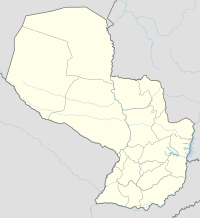Hohenau, Paraguay facts for kids
Quick facts for kids
Hohenau
|
||
|---|---|---|
|
City and district
|
||
|
||
| Country | ||
| Department | Itapúa | |
| Founded | March 14, 1900 | |
| Founded by | Carlos Reverchon, Guillermo Closs, Ambrosio Scholler and Esteban Scholler, helped by German colonists | |
| Area | ||
| • Total | 220 km2 (80 sq mi) | |
| Population
(2008)
|
||
| • Total | 11,044 | |
| • Density | 50.2/km2 (130.0/sq mi) | |
| Time zone | UTC-4 | |
| Postal code |
6290
|
|
| Area code(s) | (595) (75) | |
Hohenau is a city and district in the Itapúa Department of Paraguay. It is about 8 kilometers from Trinidad and 365 kilometers from Asunción, the capital city. Hohenau has many farms and streams nearby. Some of these streams are Capi'ivary, Poromocó, Mansisovy, and Santa María.
Contents
Meaning of the Name Hohenau
The name Hohenau comes from the German words hoch (which means 'high') and Au(e) (which means 'floodplain'). This name describes the city's location. It is on high ground that gently slopes down towards the Paraná river.
History of Hohenau
Hohenau was started on March 14, 1900. It was founded by Carlos Reverchon, Guillermo Closs, Ambrosio Scholler, and Esteban Scholler. They had help from German colonists.
Founding and Early Settlers
Guillermo Closs, one of the founders, was born in Brazil. He later moved to Paraguay. There, he met Carlos Reverchon. Together, they planned for many German immigrants to settle in the area.
With help from the Austrian consul in Paraguay, they convinced the government to allow a new colony. On September 12, 1898, the Paraguayan government gave Closs and Reverchon a large area of land. This land was in what was then the Alto Paraná, Encarnación Department.
The first settlers arrived from Encarnación on March 14, 1900. In August 1900, eight more families came. This brought the total to 55 people. This arrival led to many more people moving to the colony. Some of these early families were the Dresslers, Kuschels, Fritzes, and Jachows.
These first families faced many challenges. They dealt with diseases, a lack of supplies, and poor communication. Over time, they slowly overcame these problems. Hohenau officially became a district in 1944.
Growth and New Immigrants
In the 1930s and 1940s, people from other countries started to move to Hohenau. These included Poles, Ukrainians, and Russians. Some Belgians and French also arrived. Later, in 1958, many Japanese settlers came. These Japanese settlers later helped create the district of La Paz.
Geography of Hohenau
Hohenau covers an area of 220 square kilometers. It shares borders with several other districts. To the north and east is the Obligado district. To the south is the Trinidad district. To the west are the Jesús, La Paz, and San Pedro del Paraná districts.
The city is in an area with many water sources. These include the Paraná river and the Capi'ivary stream.
Climate in Hohenau
Hohenau has a sub-tropical climate. This climate is great for farming. Temperatures can range from 3-4 °C in winter. In summer, they can reach 37-38 °C.
Population of Hohenau
Hohenau has a total population of 7,987 people.
Economy of Hohenau
Most people in Hohenau work in agriculture. They grow many different crops. These include soy, cotton, corn, manioc, and yerba mate. They also grow tung, sorgo, citric fruits, beans, peanuts, and watermelon. Farmers also raise animals like cows, pigs, and poultry.
There are also some small factories in Hohenau. These include:
- Flour mills
- Yerba mate mills
- Wineries
- Brick factories
- Bakeries
- Saw-mills
- Carpentry shops
- Starch factories
Hohenau has a high standard of living. In fact, it has the second-highest living standard in Paraguay. Only the capital city, Asunción, is higher.
Tourism in Hohenau
One popular place for visitors is the Alto Paraná Hunting and Fishing Club. Here, people can enjoy traditional dorado fishing.
Visitors can also explore the German and Japanese colonies. These areas show unique building styles and offer typical foods. You can also see the many cultivated fields.
You can reach Hohenau by the Ruta Sexta Doctor Juan León Mallorquín road. This road goes through the city center. It connects Hohenau with Encarnación and Ciudad del Este. Other local roads link Hohenau to nearby areas.
Institutions in Hohenau
The city has many places for learning and help. There is a dance school and a culinary arts academy. You can also find tailoring and barber academies. Other places teach computer science and typewriting.
Hohenau also has several medical centers:
- SOS Aldea de Niños: This center helps children. It was founded on August 21, 1971. It has 17 buildings and helps 160 children.
- Mother and Child Hospital
- SOS Hospital: This hospital has 40 beds and sees about 2500 patients each month.
- Adventist Clinic: This clinic started helping the district and department in 1963.
Neighborhoods in Hohenau
Hohenau is divided into different areas.
City Center Neighborhoods
- San José
- San Blás
- Cerro Corá
- CONAVI
- Primavera
- Obrero
- Santa Lucía
Rural Zone Neighborhoods
- Hohenau 1 (Puerto Hohenau)
- Hohenau 2 (Centro Urbano)
- Hohenau 3 (Campo Ángel)
- Hohenau 4 (Caguarené)
- Hohenau 5 (Santa María)
See also
 In Spanish: Hohenau para niños
In Spanish: Hohenau para niños



